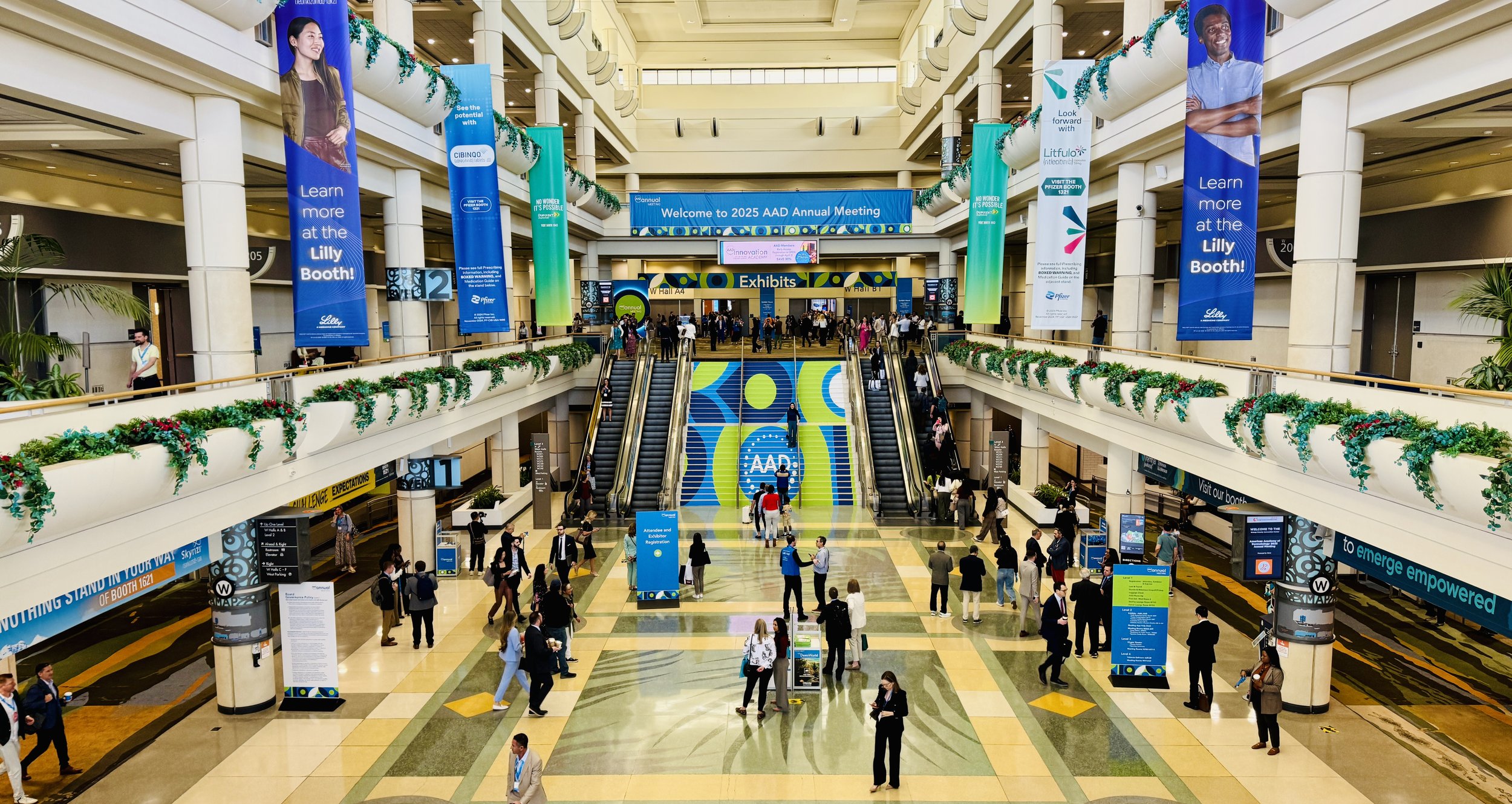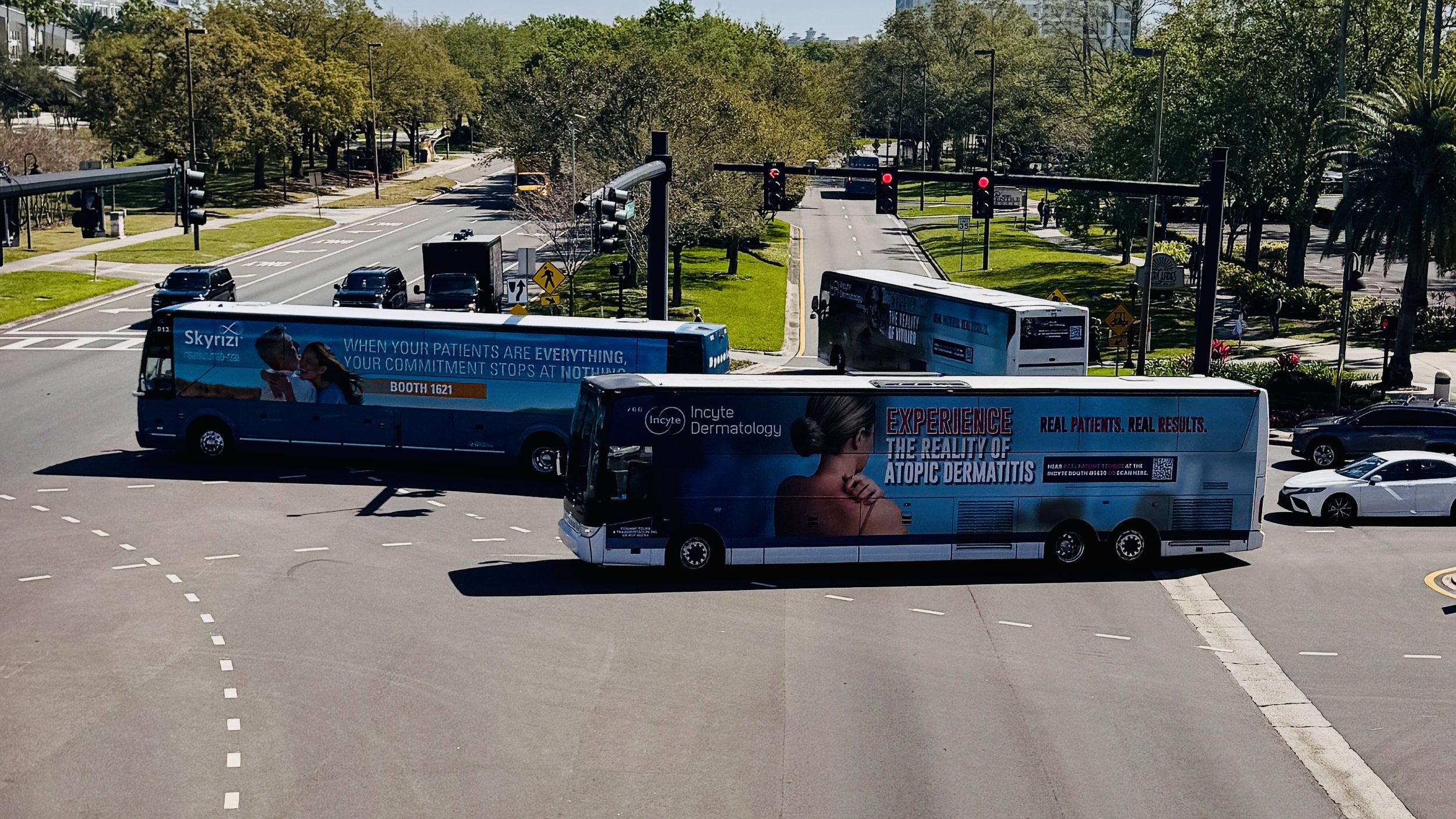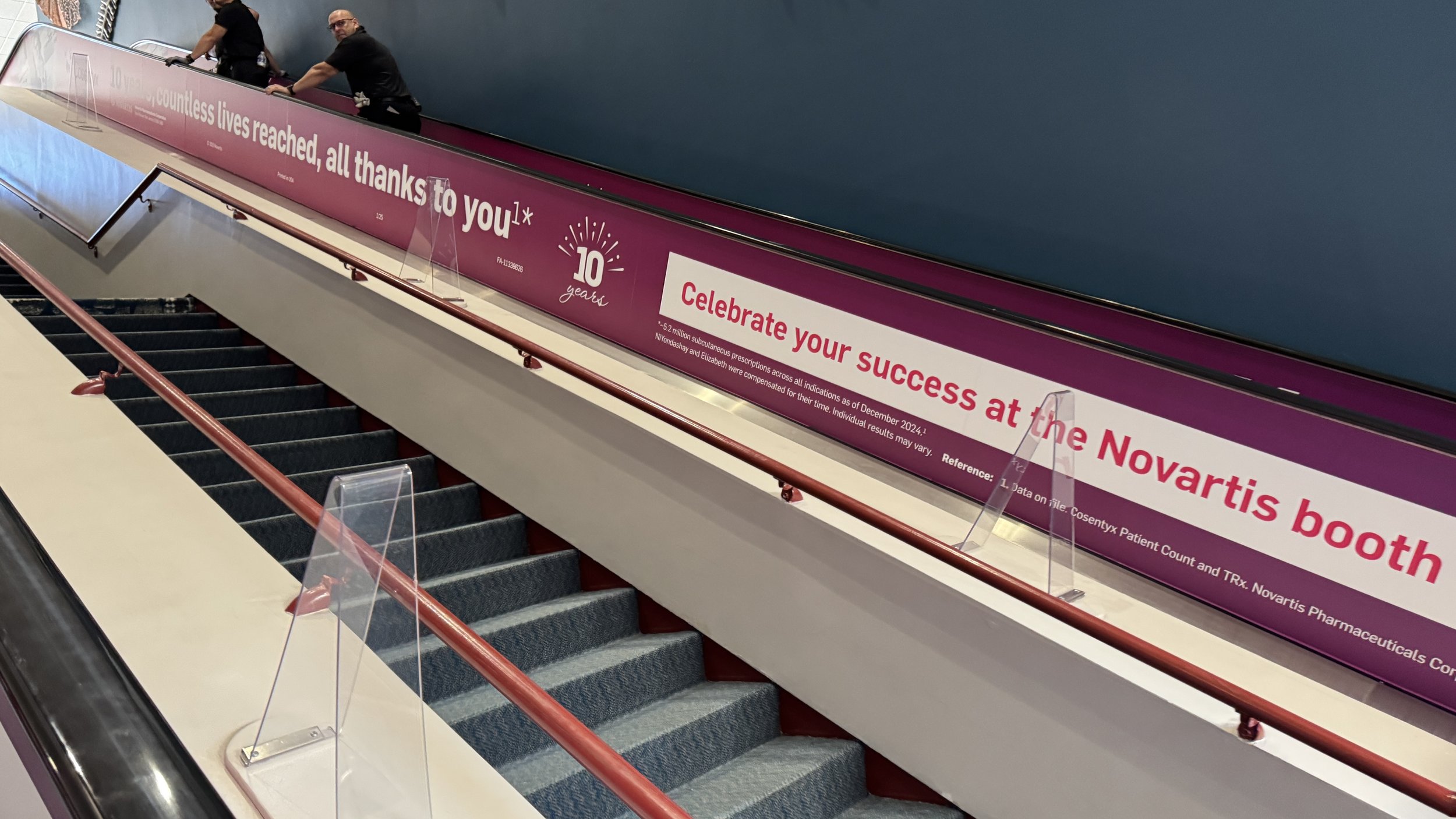
.
The 2025 American Academy of Dermatology (AAD) Annual Meeting brought together top dermatologists, researchers, and industry leaders to explore the future of skin health.
This year’s meeting broke records with over 20,000 attendees—surpassing last year’s total in San Diego—and featured 428 exhibitors and more than 7,300 exhibitor staff. Roughly half the attendees were medical professionals, with residents and non-clinical staff making up another 25%.AAD’s hybrid identity—part clinical summit, part consumer showcase—was on full display, from Martha Stewart’s widely anticipated keynote fireside chat with AAD President Dr. Seemal R. Desai to networking at Universal CityWalk, hands-on workshops, and live technique demos. Financial planning and private practice sessions rounded out a packed agenda.
The conference highlighted major advances in dermatologic drug development, with new data presented on psoriasis, atopic dermatitis, alopecia areata, and prurigo nodularis. J&J’s oral IL-23 receptor inhibitor (JNJ-2113) delivered biologic-level results in psoriasis. ZORYVE foam (roflumilast) showed strong efficacy for scalp and body psoriasis, while tapinarof cream (VTAMA®) sustained symptom-free periods post-treatment in AD. Other promising updates included deucravacitinib for cutaneous lupus, bempikibart for severe alopecia areata, and ruxolitinib cream for prurigo nodularis.
Technology also played a central role. AI tools, imaging systems, and laser devices underscored how tech is reshaping dermatologic care—from diagnostics to patient experience. Quantificare unveiled new vitiligo lesion and acne grading tools, Wingderm introduced a 1550nm non-ablative fractional laser, and Alpenglow Biosciences showcased AI-powered 3D spatial biology. Telehealth, precision diagnostics, and platforms like DataDerm were discussed as ways to expand access and improve equity.
Cosmetic dermatology drew heavy attention, with growing demand for effective, non-invasive, low-downtime solutions. MultiFrax, a dual-wavelength fractional laser, and PRX, a needle-free collagen biostimulator, were among the highlights. Early-stage research into salmon sperm DNA fragments suggested new regenerative possibilities in aesthetics.
Lifestyle-driven care was a strong theme. Experts discussed managing side effects of popular drugs like GLP-1 agonists, including hair thinning and facial volume loss, with treatments like injectables, resurfacing, and supplements. Nutrition also emerged as a factor in managing conditions like atopic dermatitis and urticaria, and sirtuin-activating foods were noted for their potential anti-aging effects.
Safety and patient education were key talking points as well, especially around tattoo inks and ingredient transparency. Equity in care was emphasized by Dr. Nada Elbuluk, the new SOCS president, alongside sessions on mentorship, DEI, and generational shifts in the field. Social media’s growing influence in dermatology sparked debate, highlighting the need to balance education, self-promotion, and professionalism in a digital age.
Social media captured the broad range of activities.
Competition for face time started well before attendees stepped into the exhibit hall.
With promotional rules tightening what companies could say, brands shifted their focus to what they could show—and how often they could be seen.
Visual dominance became the name of the game, and brands relied on design, placement, and atmosphere to make their mark. The smartest ones did it by thinking beyond the banner.
-

Canine Cuddle Zone
CareCredit’s “Cuddle Zone,” a soft lounge area designed for comfort, stood out as a break from the clinical noise—an unexpected touchpoint that drew attention by appealing to human needs.
-
Escalator Graphics
Novartis made a strong visual play with escalator graphics in high-traffic areas—an efficient move that maximized exposure without overspending.
-

Food Truck
AbbVie, always a heavyweight at these events, sponsored a food truck to pull in crowds and extend their brand experience beyond the booth.
-

Bus Wrap
Bus wraps for J&J’s Tremfya and Arcutis’ ZORYVE seemed to circle the convention center nonstop, reinforcing presence through sheer repetition.
-

Uber
EltaMD took a more personal route, sponsoring Ubers to get one-on-one visibility during rides.
-

Wifi
Arcutis sponsored wifi for AAD visitors.
Not all big booths were created equal.
The top five sponsors at AAD—AbbVie, Pfizer, Sanofi/Regeneron, Novartis, and Eli Lilly—underscored their dominant positions in dermatology . Each brought a major footprint, using high-impact visuals, interactive programming, and tightly integrated scientific messaging to reinforce their leadership in key therapeutic areas like psoriasis, atopic dermatitis, and hidradenitis suppurativa.
AbbVie once again set the tone with a commanding presence centered on its blockbuster immunology portfolio, blending sleek design with curated clinical content that kept healthcare providers engaged. Pfizer leaned into education, offering a clear narrative around innovation and patient outcomes, while Sanofi/Regeneron spotlighted their partnership with a unified booth experience that showcased both clinical data and patient-centric storytelling. The brand’s bold color scheme helped it stand out and was foundational to perhaps the best execution of fair balance on the show floor.
Novartis used elegant booth architecture and expert-led presentations to communicate pipeline depth, while Eli Lilly stood out for its dynamic engagement zones and emphasis on digital integration—reflecting a broader strategy to connect with younger physicians and tech-savvy HCPs. EBGLYSS front and center, but Lilly’s gargantuan kiosks and muddled branding diminished its impact.
Lilly, Johnson & Johnson, Sanofi, and Novartis ran tight, clear, engaging exhibits. Their booths managed to be busy without becoming chaotic, and they struck the right balance between brand storytelling and clinical substance.
While the “Big Five” delivered as expected, not all large exhibitors hit the mark. On the flip side, some big names missed. UCB’s booth could benefit from more energy and clearer messaging. Even Novartis, despite being strong overall, had moments where its layout and staff engagement didn’t quite land. At this scale, success is about more than money—it’s about execution.
Among tech and device companies, booth placement was everything—those positioned near the giants saw increased foot traffic, while others were tucked away and missed key opportunities for visibility. Smaller players in AI, imaging, and diagnostics found it difficult to break through the noise without a strong hook or standout programming.
The winners didn’t just show up big; they showed up smart.
For many exhibitors, opening day was a story of quantity vs. quality.
As usual, the show floor was a sea of people—not moving. Dozens of booths drew long queues, with average wait times hovering around 30 minutes. The line into l’Oréal’s sprawling exhibit was typical, easily 200 deep, weaving through multiple zones in their own exhibit and extending into the aisles blocking access to their neighbors. At peak times, it was nearly impossible to navigate certain aisles, penalizing l’Orêal’s neighbors.
P&G managed crowds better with structured presentations, calmly leading ~100 people at a time through a 15-minute wait and a 12-minute presentation. At the conclusion of the presentations, reps stood ready to engage.
Some exhibitors tried to turn the wait into an opportunity, but in most cases, the crowds were overwhelming. There’s value in a crowd, sure—but only if you can actually reach the people in it.
Yes, giveaways are a draw. But when your audience—highly educated, time-starved professionals—is spending hours in line for swag, you have to ask: is this helping or hurting engagement?
A clear divide emerged between non-pharma and pharma booths.
Non-pharma brands had more freedom to offer immersive, interactive experiences—Neutrogena’s custom scrubs and CeraVe’s brand history walkthroughs drew consistent attention. In contrast, pharma relied on structure, content, and hospitality. Standouts included Botox’s lounge, BMS’s branded “Winkaccinos,” and Takeda’s culturally rooted Tea House.
Engagement tactics ranged from the creative to the tried-and-true.
Beyond the towering booths and medical deep dives, many brands at AAD leaned into inventive engagement tactics to attract attendees and drive memorable interactions. From passport-style badge scans that gamified the booth journey to build-your-own swag stations and hands-on product demos, creativity was on full display.
Beiersdorf (parent company of Eucerin and Aquaphor) offered tactile skincare trials with hydration sensors and sensory feedback tools, inviting HCPs to experience their products’ impact firsthand. Bubble, the Gen Z skincare favorite, brought its playful branding to life with a fresh, youthful booth design and social-media-ready moments—positioning itself as a bridge between consumer trends and clinical relevance.
Boehringer Ingelheim focused on interactivity through a digital “path to patient” journey, emphasizing its commitment to innovation in immune-dermatology. Bristol Myers Squibb took a more narrative approach, weaving storytelling into its booth design with patient case studies and a rotating lineup of thought leader presentations that drew steady crowds.
And then there was Vanicream, which quite literally built a monument to its core mission. Their towering “dry skin installation” was both tongue-in-cheek and informative—doubling as a selfie magnet and a tactile educational tool that visualized the impact of dermatologic conditions on different skin types. It was a reminder that even heritage brands can surprise when they embrace bold, on-theme creativity.
Many exhibitors embraced the next generation.
Younger HCPs and residents were clearly a target. Brands like Neutrogena and Bubble catered to them through social media, influencer-friendly aesthetics, and interactive content. Exhibitors increasingly spoke the language of a digitally native, diversity-conscious generation—one that’s reshaping the dermatology conversation online.
Even large companies joined the movement: Sanofi/Regeneron and Takeda featured live Instagram feeds in their booths, while Biersdorf displayed a full social media wall—signaling that digital relevance is no longer optional.
Startups and consumer brands like first-time exhibitor Bubble weren’t just looking to connect with professionals—they were targeting the younger, social-media-savvy crowd that’s reshaping how dermatology is talked about online. The industry is taking note: younger clinicians aren’t just future prescribers; they’re current influencers.
It’s not just about age, either. There’s a broader shift toward speaking the language of the emerging professional class—digitally fluent, diversity-conscious, and hungry for authenticity. If you want their attention, you need more than a glossy booth.
A few more highlights from the AAD show floor.
The large exhibitors weren’t the only ones bringing fresh ideas. Several smaller booths stood out with sharp design, clear messaging, and smart engagement tactics that held their own on the crowded floor.
Our advice for future AAD exhibitors who want skin in the game.
AAD 2025 reaffirmed the rapid evolution of dermatology—from drug breakthroughs to device innovation and shifting patient expectations. The meeting fused scientific rigor with consumer energy, creating a unique dynamic few specialties can match. But beneath the buzz, one lesson stood out: success at AAD isn’t about having the biggest booth. It’s about clarity, creativity, and meaningful connection.
The exhibit hall made that clear. High traffic didn’t always translate to high impact. Some brands drew long lines but failed to engage once people got inside. Others planned meticulously—guiding attendees through their space with purpose, balancing striking visuals with substance, and creating touchpoints that stuck. Strategy, not spectacle, separated the memorable from the forgettable.
What we saw at AAD this year didn’t happen in a vacuum. Just 46 days into a new administration, seismic shifts in governmental oversight began rippling through the healthcare landscape—most notably at the FDA, where layoffs and leadership changes raised questions about future regulatory timelines, clinical approvals, and how companies plan and prioritize product launches. These uncertainties showed up in more cautious messaging, a heavier presence of pipeline discussions rather than splashy launches, and a tone of strategic restraint on the show floor. Stay tuned for more thoughts on what’s ahead.
You can’t just show up and expect results. The most effective exhibitors considered every detail: how to manage flow, capture attention, and deliver value in a short interaction. Others got caught in the chaos, relying on giveaways or gimmicks without a deeper story or takeaway.
One thing everyone could agree on: the AAD show floor is unlike any other. It’s a collision of clinical and commercial, serious science and skincare glitz. That mix brings unmatched energy—but it also demands a smarter approach to engagement.
And maybe—just maybe—next year, someone will finally solve the line problem.


















































